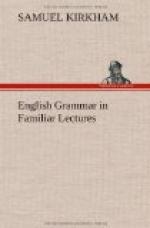Emphasis affects particular words and phrases; but tones affect sentences, paragraphs, and sometimes a whole discourse.
PUNCTUATION.
PUNCTUATION is the art of dividing written composition into sentences or parts of sentences, by points or stops, in order to mark the different pauses which the sense and an accurate pronunciation require.
The Comma represents the shortest pause; the Semicolon, a pause double that of the comma; the Colon, double that of the semicolon; and the Period, double that of the colon.
Punctuation is a modern art. The ancients were entirely unacquainted with the use of points; and wrote, not only without any distinction of members and periods, but also without any distinction of words. This custom continued till the year 360 before Christ. How the ancients read their works, written in this manner, it is not easy to conceive. After the practice of joining words together had ceased, notes of distinction were placed at the end of every word. This practice continued a considerable time.
As it appears that the present usage of points did not take place while manuscripts and monumental inscriptions were the only known methods of conveying knowledge, we must conclude, that it was introduced with the art of printing. The introduction was, however, gradual: all the points did not appear at once. The colon, semicolon, and note of admiration, were produced some time after the others. The whole set, as they are now used, became established, when learning and refinement had made considerable progress.
As the rules of punctuation are founded altogether on the grammatical construction of sentences, their application pre-supposes, on the part of the student, a knowledge of Syntax. Although they admit of exceptions, and require a continual exercise of judgment and literary taste in applying them properly, they are of great utility, and justly merit our particular attention.
The great importance of acquiring a thorough knowledge of punctuation, and of attending strictly to the application of its rules, is established by the single fact, that the meaning of a sentence is often totally perverted by the omission or misapplication of points. To illustrate the correctness of this remark, numerous example might be selected. The following border on the ridiculous: “Mr. Jared Hurton having gone to sea his wife, desires the prayers of this church:” “Tryon, who escaped from the jail on Friday last, is 22 years of age, has sandy hair, light eyes, thin visage, with a short nose turned up about six feet high, &c.” Corrected; “Mr. Jared Hurton having gone to sea, his wife desires the prayers of this church;” “thin visage, with a short nose turned up, about six feet high, &c.”
Before one enters upon the study of punctuation, it is necessary for him to understand what is meant by an adjunct, a simple sentence, and a compound sentence.




